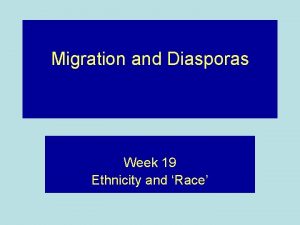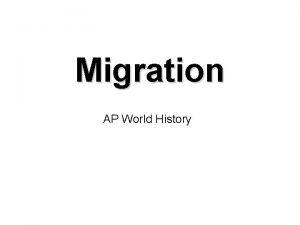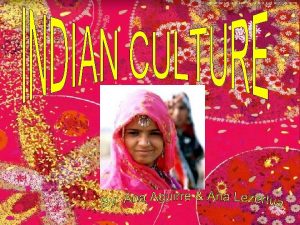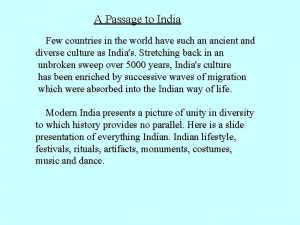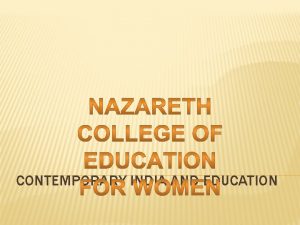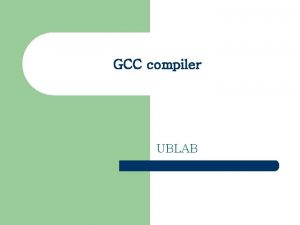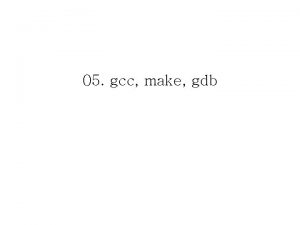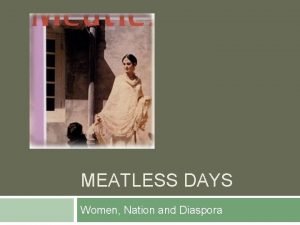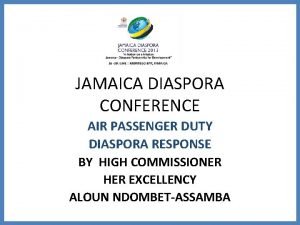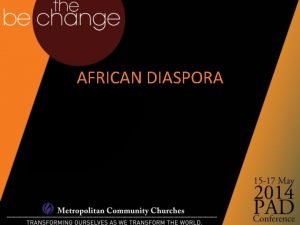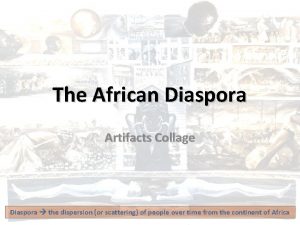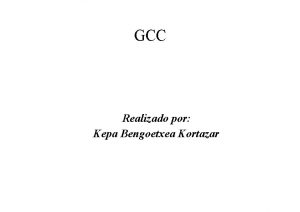India and GCC Countries Diaspora Development International Seminar















- Slides: 15

India and GCC Countries: Diaspora & Development International Seminar on New Dimensions of Indo-Arab Relations 11 -12 August 2009 Department of Arabic Maharaja’s College, Ernakulam N. Shamnad Department of Arabic, University College, Thiruvananthapuram, Kerala

What is « Diaspora » ? a Greek word meaning ‘dispersion’, referred to the various Jewish communities «living in exile outside Palestine» Now commonly used in a generic sense for communities of migrants living or settled in other countries, aware of its origin and identity and maintaining varying degrees of linkages with the mother country

The great Indian diaspora ¨ 20 million Indian diaspora or non-resident Indian ¨ ¨ ¨ community worldwide Envoys of Enterprise Generating an annual income equal to 35 percent of India's gross domestic product. Account for an economic output of about $400 billion (Rs 19, 20, 000 crore). Migration of Indian Diaspora has not resulted in 'Brain -Drain' but 'Brain-Gain'. Significant contribution towards the growth and development in India. Contributing towards improved Indo-International relations

Gulf Cooperative Council (GCC) Countries The 6 Gulf Region States of the Arabian Peninsula located at the west coast of the Arabian Gulf and east coast of Red Sea 1. Saudi Arabia 2. United Arab Emirates (UAE) 3. Kuwait 4. Bahrain 5. Qatar 6. Oman Kuwait Red Sea Arabian Gulf Bahrain UAE Qatar Oman Saudi Arabian Sea

India in GCC countries An estimation of around 6 million (2008 -2009) Indians About 40% of the population in the UAE are of Indian Semiskilled-unskilled workers : 70% White-collar workers : 20% Professionals : 10% ¨ ¨ ¨ ¨ Over 60% have had little formal education A majority of these NRIs are young males. Usually fed and housed in barrack-like tenements. Most of them are unmarried. Formal and impersonal Interactions with the local people. Drawn to their compatriots of a similar social status or background. A large number of Indian associations based on commonalties Initiative of setting up a large number of schools throughout the region Source: http: // indiaspora. nic. in , Report of High Level committee submitted to Govt. of India on Indian Diaspora in the Gulf States Region

Migration: Why? ¨ Gulf Oil Boom in 1970 s ¨ Geographical proximity to India ¨ Historical relationship ¨ Indian Human capital ¨ Big projects in gulf ¨ Good Income ¨ Increase of unemployment in India

Stocks of Indian Migrant Population in the GCC Countries, Selected years: 1975– 2001 Source: Rajan, I. S. (2003), «Dynamics of International Migration from India: Its Economic and Social Implications» , Centre for Developmental Studies, Thiruvananthapuram.

Government measures for better migration management ¨ The Emigration Act, 1983 to ensure protection to vulnerable ¨ ¨ ¨ categories Registration of «Recruiting Agents» The new Ministry of Overseas Indian Affairs formed in 2004 «Overseas Indian» , the house journal of the Ministry Overseas Citizenship of India: the dual citizenship Proposed migrant right to exercise votes from abroad Introduction of a compulsory insurance scheme: «Pravasi Bharatiya Bima Yojana» Institution of «Pravasi Bharatiya Diwas» since 2003 Set up of NORKA by the Government of Kerala in 1996 Norka-Roots as an interface between the migrants and the Government of Kerala since 2002 Pravasi Identity Card- project since 2008 Pravasi Welfare Act 2008

The Big Nos ! ¨ No systematic legal policy framework to deal with emigration out of the country ¨ No documentation of international migration data exists in India, not to talk of its various sub– categories ¨ No comprehensive data are available on women migrants ¨ No studies on the impact of skilled migration on career choices and educational choices in India

Indian Workers Granted Emigration Clearance by Major Indian States, 2000– 2005 Source: Khadria, Binod (2006), «India: Skilled Migration to developed countries, Labour migration to Gulf» , P 17.

The case of Kerala ¨ About two million people from Kerala work abroad, almost 90% are in the Gulf ¨ One out of every three or four Indians living in Gulf has been a Keralite. ¨ Non-resident Keralites (NRKs) send back close to US$8 billion in remittances annually, more than double the state's tax revenues ¨ NRKs have remitted more than US$42 billion to Kerala in the last 35 years A common aspiration: «to emigrate to the Gulf, earn a lot of money, get married, and live happily ever after» Who is this gulf malayalee? Many are poor, semi-skilled, taken loans, often from moneylenders, to pay recruitment agents, work 12 -hour days, live without their families in harsh conditions, earn and send most of the money home.

Gulf syndrome: ¨ ¨ ¨ Socio–Economic gains and losses Significant impact on savings. Increase in the consumption of the people in Kerala House building activities Lack of development potential of remittance receipts and financial bankruptcy later Creation of a climate of resentment against the «new rich» among the other sections Removal of the «poverty of education» and the «poverty of health» . Enhanced family investment in education. Opening up of a large number of new schools and colleges Rise in unemployment rate due to education Emergence of «replacement migration» of labour into Kerala from other Indian states Transformation of about one million women into efficient home managers. Social and psychological problems of the «Gulf Wives» and the loneliness of the «Gulf Parents»

Reverse Exodus ? ¨ More than 2, 000 workers in the Gulf have returned to India as ¨ ¨ ¨ a result of the delay in execution of projects due to recession. The workers in UAE seemed to be most affected. The most visible impact on the construction industry appears to be in Dubai. No official estimate of how many people are returning every week. The Indian embassy in the UAE could not give precise figures of returnees. 200, 000 to 500, 000 gulf Keralites likely to return home by July 2009 – Dr. T. M. Thomas Isaac, State finance minister. Around 1, 500 to 2, 000 fishermen from Sakthikulangara were employed in prestigious sea reclamation projects in the UAE, Due to the recession, almost 90% are back. Source: The Guardian, Monday 6 April 2009, http: //www. guardian. co. uk/world/2009/apr/06/

How to handle the return ? ¨ No all India level fiscal help ¨ The ministry of Overseas Indian Affairs was expecting a ¨ ¨ budgetary support for setting up a fund for returning Indian workers but the request could not be accommodated in the union budget of 2009. The state budget, 2009 allotted Rs. 100 cr. for providing soft loans to Gulf returnees Kerala has set up a loan package to help returnees start small businesses from their homes. The state-owned Kerala Financial Corporation (KFC) will handle the package for Gulf returnees by providing entrepreneurial loans at a low interest rate. Kerala has sought the GCC help to rehabilitate thousands of Gulf returnees by contributing to the state government fund. Source: The Hindu business line, Thursday, Jun 04, 2009

After word: It is indeed paradoxical that the average per–hour contribution of each employed worker within India to the production of India’s GDP has been amongst the lowest in the world – a mere 37 cents as compared to the United States’ 37 dollars, i. e. , one– hundredth of the latter. This is naturally ironical, because the same average Indian employed abroad contributes very high average share to the GDP of the country !!! Thank You
 Types of diaspora
Types of diaspora Diaspora grega
Diaspora grega Lilian origem
Lilian origem Diaspora grega
Diaspora grega Diaspora grega
Diaspora grega Diaspora ap world history
Diaspora ap world history Diaspora start-up
Diaspora start-up Homestrings
Homestrings Neighbouring countries of india
Neighbouring countries of india Few countries are as great as india
Few countries are as great as india Few countries are as great as india
Few countries are as great as india Seminar on education in india
Seminar on education in india Command gcc
Command gcc Gcc logo
Gcc logo Gcc atom
Gcc atom Glendale nursing program
Glendale nursing program
